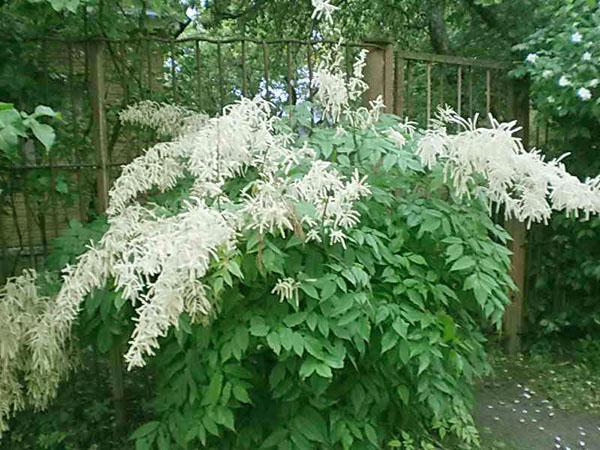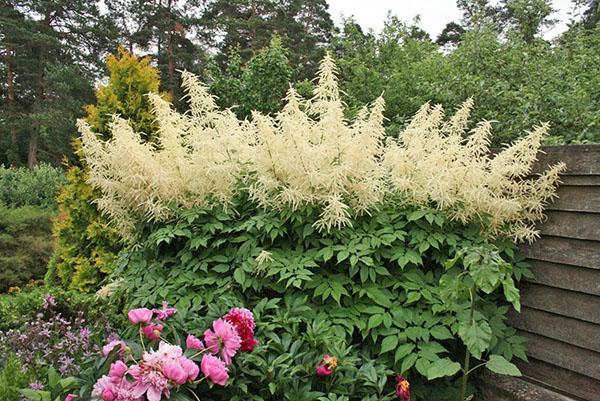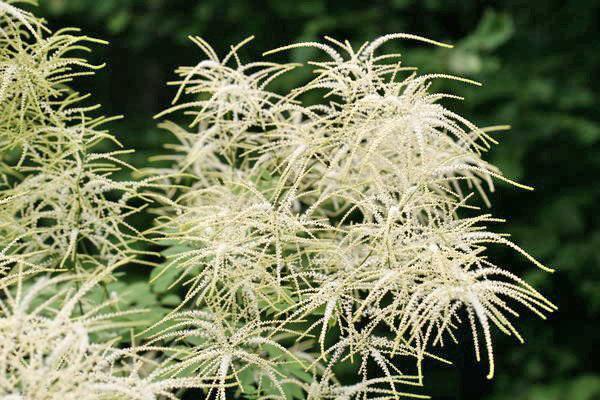Rules for growing Volzhanka shrubs in the garden
 Recently, the perennial Volzhanka is increasingly used in landscape design due to the unusual shape of the leaves, the high decorativeness of the inflorescences, exuding a subtle sweet aroma. The cultivation of the Volzhanka shrub will not cause much trouble to the owner, because the culture is very unpretentious to the quality of the soil, illumination, it is easily restored after mechanical damage to the trunk. The types of shrubs, the intricacies of planting and caring for a plant will be discussed in this publication.
Recently, the perennial Volzhanka is increasingly used in landscape design due to the unusual shape of the leaves, the high decorativeness of the inflorescences, exuding a subtle sweet aroma. The cultivation of the Volzhanka shrub will not cause much trouble to the owner, because the culture is very unpretentious to the quality of the soil, illumination, it is easily restored after mechanical damage to the trunk. The types of shrubs, the intricacies of planting and caring for a plant will be discussed in this publication.
Volzhanka shrub: description and characteristics

Despite the similar name, the Gozloborodnik plant is not a relative of Aruncus.
In nature, culture grows in temperate climatic zones on the banks of streams, in forest belts, ravines. Volzhanka can also be found in the mountain gorges.
Aruncus is a herbaceous plant with a stem modified into an underground powerful rhizome:
- Leaves are unpaired, with a jagged edge. The sheet plate is matte.
- The flowers are small, with five petals, united in complex dissected paniculate inflorescences of white or cream color.
- The size of the bush can reach 2 m. In height and 1.5 m. In diameter.
Aruncus is a dioecious plant: male and female flowers are found on different plants. Pollination occurs by pollinating insects, which are attracted by the honey aroma exuding the flowers.
Species diversity
 About 12 species of aruncus are known in nature, but no more than five are used in landscape design.
About 12 species of aruncus are known in nature, but no more than five are used in landscape design.
Asian Volzhanka
 Ornamental shrub up to 2 m high. Leaves are hard, overweight. The flowers are small white, collected in paniculate inflorescences, reaching a length of 40 cm. Flowering begins in early summer and lasts 30 days. Asiatic aruncus has a high cold hardiness and is suitable for growing in northern regions. There are undersized varieties of this species up to 100 cm high.
Ornamental shrub up to 2 m high. Leaves are hard, overweight. The flowers are small white, collected in paniculate inflorescences, reaching a length of 40 cm. Flowering begins in early summer and lasts 30 days. Asiatic aruncus has a high cold hardiness and is suitable for growing in northern regions. There are undersized varieties of this species up to 100 cm high.
Volzhanka ordinary
 Sprawling bush, up to 2.5 m high. Compound overweight leaves. The length of the inflorescences reaches 50 cm. Male inflorescences are denser than female ones. The flowering time lasts up to 40 days.
Sprawling bush, up to 2.5 m high. Compound overweight leaves. The length of the inflorescences reaches 50 cm. Male inflorescences are denser than female ones. The flowering time lasts up to 40 days.
The most common varieties used in landscape design:
- Kneffi is a culture with a height of 50 to 80 cm. Inflorescence color is light cream.

- Horatio is a low-growing plant with a stem height of up to 60 cm. The color of the stems is burgundy-red.

- Perfection - undersized compact bush, up to 50 cm high. The color of the inflorescences is white.

- Misty Lace is a drought tolerant variety. The color of the panicles is cream.

Kamchatka
 The bush is up to 1.5 m high. The peculiarity of this species is the more delicate foliage and the relatively small size of the inflorescences (up to 20 cm).
The bush is up to 1.5 m high. The peculiarity of this species is the more delicate foliage and the relatively small size of the inflorescences (up to 20 cm).
Chinese
 Chinese Volzhanka is a shrub up to 1.5 m high. Inflorescences of white and cream color up to 30 cm long. A distinctive feature of the plant is over-mature, brownish-green leaves.
Chinese Volzhanka is a shrub up to 1.5 m high. Inflorescences of white and cream color up to 30 cm long. A distinctive feature of the plant is over-mature, brownish-green leaves.
Varieties of Volzhanka dwarf

Very often in landscape design, low-growing varieties of Volzhanka are used:
- Aruncus is korotyshy. The shrub height usually does not exceed 25 cm.

- Alpine Volzhanka (f. Alpina), the height of which varies around 30 cm.
There is a miniature variety of Asiatic Volzhanka. The average height of the shrub is 20-30 cm.
Planting, care and cultivation of Volzhanka shrub

Culture propagates in two ways:
- Vegetative, by separating the shoot from the "mother" plant. The shoot with a part of the rhizome is planted in a substrate, which consists of 2 parts of soil and 1 part of humus. With this method of planting, flowering occurs in a year.
- By planting seeds. Growing aruncus from seeds is a longer way to obtain an ornamental plant. Flowering occurs only in the third year after planting.
Sow seeds in autumn in boxes filled with prepared moist soil. To prevent drying out, the planting site should be mulched. After germination, the seedlings are planted in open ground at a distance of 15 cm from each other.
Planting and caring for an undersized Volzhanka requires knowledge of certain nuances:
- Soil requirements. The soil must be nutritious. Organic fertilizers are applied to the hole just before planting the seedling. One plant needs 2 kg peat and 1 tbsp. l. nitrophosphate.
- The hole diameter is 40 cm, the planting depth is 40 cm.The distance between the holes is 1 m.
- The hole is spilled with water, the roots of the plant are straightened, after which they are covered with prepared soil, the planting site is trampled down and spilled with water.
Caring for dwarf varieties of aruncus consists in periodic weeding, loosening the soil and watering the plant. After flowering, dried shoots and flowers are cut off.
 It is quite simple to grow Volzhanka plants, because the culture does not impose special requirements on soil and lighting. Aruncus grows on heavy, medium and light soils with an acidity of 5.0 - 7.0 PH. Direct sunlight can leave noticeable burns on the leaves, which can lead to disease or death of the plant. A characteristic feature of Volzhanka is a large leaf mass, as a result of which the plant quickly loses moisture. In the summer, the culture needs regular root watering.
It is quite simple to grow Volzhanka plants, because the culture does not impose special requirements on soil and lighting. Aruncus grows on heavy, medium and light soils with an acidity of 5.0 - 7.0 PH. Direct sunlight can leave noticeable burns on the leaves, which can lead to disease or death of the plant. A characteristic feature of Volzhanka is a large leaf mass, as a result of which the plant quickly loses moisture. In the summer, the culture needs regular root watering.
Volzhanka is responsive to organic feeding:
- Introduction organic fertilizers should be carried out when loosening in late autumn and early spring.
- Immediately before the growing season, you can organize additional feeding with complex mineral fertilizers.
- Phosphate fertilizers are best applied after flowering.
In autumn, the bushes must be cut "on a stump" and mulched with sawdust, peat, humus, and covered with agrofibre.
Volzhanka diseases

Despite the fact that Volzhanka is considered a strong plant with strong immunity, during the cultivation process, the gardener may encounter pests on the crop, such as:
- aphid;
- mite;
- leaf-eating sawfly caterpillar.
As a prophylaxis for damage to crops by pests, you can use the method of spraying with soapy water. This must be done before the start of the growing season. If pests are found not in the stems and foliage, the plant should be immediately treated with specialized insecticides.
Volzhanka in landscape design
Throughout the growing season, aruncus does not lose its decorative properties. The main task of the Volzhanka is to hide unsightly areas of the landscape, fences, hedges or to create a background for other plants.
 Aruncus hides an unsightly area.
Aruncus hides an unsightly area.
 Planting Volzhanka as a background.
Planting Volzhanka as a background.
Nevertheless, Volzhanka looks great, both in solo plantings and in group plantings, where the culture can act in the center of the flower arrangement.
 Dwarf Volzhanka in a group planting.
Dwarf Volzhanka in a group planting.
The plantings of the Volzhanka look great for decorating artificial reservoirs and ponds.
 Volzhanka in a group planting of a pond decor.
Volzhanka in a group planting of a pond decor.
Aruncus prefers shady corners of the garden. That is why shade-loving plants are planted as "companions" in creating flower arrangements:
- variegated hosts;
- ferns;
- varieties spirea japonica.
Tall varieties of Volzhanka go well with low-growing astilbe, barberry, cotoneaster.
Below is one of the options for creating a flower bed with the participation of the common volzhanka dioecious.
Arunkus perfectly complements compositions in the style of "ethno" and "country", perfectly combined with logs, stones and garden elements.
Planting and caring for Volzhanka flowers will not require much work from the gardener. The culture is not demanding on the soil, it multiplies easily and grows quickly, goes well with other plants and looks great in solo compositions.